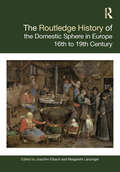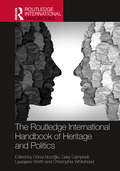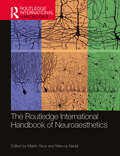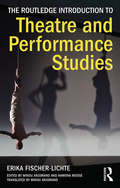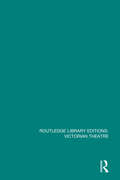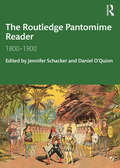- Table View
- List View
The Routledge Handbook on the Influence of Built Environments on Diverse Childhoods (Routledge International Handbooks)
by Kate Bishop Katina DimouliasChildren and young people are often discussed as if they are homogenous groups. The reality is, of course, very different, with an enormous variation within each of these groups and in any domain of experience pertaining to childhood or adolescence. Driven by personal, sociocultural, geographic, or economic circumstances, many children and young people worldwide are experiencing a totally different reality to those who fit with more mainstream patterns of childhood. This has substantial implications for their sociophysical environmental experience and our understanding of their physical environmental needs. The aim of this book is to draw attention to these alternate realities for a number of these groups of children and young people, highlighting the unique and different considerations associated with their particular circumstances in each instance, and identifying the repercussions for their physical environmental needs. Ultimately, this book creates an evidence-based discussion which can be used by designers, planners and policy makers, and those delivering services and programs to children and young people as a basis to make informed decisions on how to work with the groups of children and young people in our book for better environmental provision.
The Routledge Handbook on the Reception of Classical Architecture
by Nicholas Temple Andrzej Piotrowski Juan Manuel HerediaThis is the first comprehensive study of the reception of classical architecture in different regions of the world. Exploring the impact of colonialism, trade, slavery, religious missions, political ideology and intellectual/artistic exchange, the authors demonstrate how classical principles and ideas were disseminated and received across the globe. By addressing a number of contentious or unresolved issues highlighted in some historical surveys of architecture, the chapters presented in this volume question long-held assumptions about the notion of a universally accepted ‘classical tradition’ and its broadly Euro-centric perspective. Featuring thirty-two chapters written by international scholars from China, Europe, Turkey, North America, Mexico, Australia and New Zealand, the book is divided into four sections: 1) Transmission and re-conceptualisation of classical architecture; 2) Classical influence through colonialism, political ideology and religious conversion; 3) Historiographical surveys of geographical regions; and 4) Visual and textual discourses. This fourfold arrangement of chapters provides a coherent structure to accommodate different perspectives of classical reception across the world, and their geographical, ethnographic, ideological, symbolic, social and cultural contexts. Essays cover a wide geography and include studies in Italy, France, England, Scotland, the Nordic countries, Greece, Austria, Portugal, Romania, Germany, Poland, India, Singapore, China, the USA, Mexico, Brazil, New Zealand and Australia. Other essays in the volume focus on thematic issues or topics pertaining to classical architecture, such as ornament, spolia, humanism, nature, moderation, decorum, heresy and taste. An essential reference guide, The Routledge Handbook on the Reception of Classical Architecture makes a major contribution to the study of architectural history in a new global context.
The Routledge Handbook on the Reception of Classical Architecture
by Nicholas Temple Andrzej Piotrowski Juan Manuel HerediaThis is the first comprehensive study of the reception of classical architecture in different regions of the world. Exploring the impact of colonialism, trade, slavery, religious missions, political ideology and intellectual/artistic exchange, the authors demonstrate how classical principles and ideas were disseminated and received across the globe. By addressing a number of contentious or unresolved issues highlighted in some historical surveys of architecture, the chapters presented in this volume question long-held assumptions about the notion of a universally accepted ‘classical tradition’ and its broadly Euro-centric perspective. Featuring thirty-two chapters written by international scholars from China, Europe, Turkey, North America, Mexico, Australia and New Zealand, the book is divided into four sections: 1) Transmission and re-conceptualisation of classical architecture; 2) Classical influence through colonialism, political ideology and religious conversion; 3) Historiographical surveys of geographical regions; and 4) Visual and textual discourses. This fourfold arrangement of chapters provides a coherent structure to accommodate different perspectives of classical reception across the world, and their geographical, ethnographic, ideological, symbolic, social and cultural contexts. Essays cover a wide geography and include studies in Italy, France, England, Scotland, the Nordic countries, Greece, Austria, Portugal, Romania, Germany, Poland, India, Singapore, China, the USA, Mexico, Brazil, New Zealand and Australia. Other essays in the volume focus on thematic issues or topics pertaining to classical architecture, such as ornament, spolia, humanism, nature, moderation, decorum, heresy and taste. An essential reference guide, The Routledge Handbook on the Reception of Classical Architecture makes a major contribution to the study of architectural history in a new global context.
The Routledge Handbook to Spanish Film Music (Routledge Music Handbooks)
by Laura MirandaThe Routledge Handbook to Spanish Film Music provides a significant contribution to the research and history of Spanish film music, exploring the interdependence and ways in which discourses of sound and vision are constructed dialogically in Spanish cinema, with contributions from leading international researchers from Spain, the USA, the UK, France and Germany.Offering a multifocal and multidisciplinary study between related areas such as music studies, film studies and Spanish cultural studies, this book is divided into four sections, covering the early years of Spanish cinema; the 1940s and 1950s in Spanish cinema—the first decades of the Franco dictatorship; the importance of Fraga Iribarne’s slogan, “Spain is different,” to promote Spain’s new openness to the world in the 1960s and 1970s; and Spanish cinema since the arrival of democracy in 1978, including discussion of contemporary Spanish cinema.The growing interest in Spanish cinema calls for the publication of studies about the role of music in its political and socio-cultural framework. This is therefore a valuable text for music and film scholars and professionals, university undergraduates and music conservatory students.
The Routledge Handbook to Spanish Film Music (Routledge Music Handbooks)
The Routledge Handbook to Spanish Film Music provides a significant contribution to the research and history of Spanish film music, exploring the interdependence and ways in which discourses of sound and vision are constructed dialogically in Spanish cinema, with contributions from leading international researchers from Spain, the USA, the UK, France and Germany.Offering a multifocal and multidisciplinary study between related areas such as music studies, film studies and Spanish cultural studies, this book is divided into four sections, covering the early years of Spanish cinema; the 1940s and 1950s in Spanish cinema—the first decades of the Franco dictatorship; the importance of Fraga Iribarne’s slogan, “Spain is different,” to promote Spain’s new openness to the world in the 1960s and 1970s; and Spanish cinema since the arrival of democracy in 1978, including discussion of contemporary Spanish cinema.The growing interest in Spanish cinema calls for the publication of studies about the role of music in its political and socio-cultural framework. This is therefore a valuable text for music and film scholars and professionals, university undergraduates and music conservatory students.
The Routledge History of Italian Americans (Routledge Histories)
by William Connell Stanislao PuglieseThe Routledge History of Italian Americans weaves a narrative of the trials and triumphs of one of the nation’s largest ethnic groups. This history, comprising original essays by leading scholars and critics, addresses themes that include the Columbian legacy, immigration, the labor movement, discrimination, anarchism, Fascism, World War II patriotism, assimilation, gender identity and popular culture. This landmark volume offers a clear and accessible overview of work in the growing academic field of Italian American Studies. Rich illustrations bring the story to life, drawing out the aspects of Italian American history and culture that make this ethnic group essential to the American experience.
The Routledge History of Italian Americans (Routledge Histories)
by William Connell Stanislao PuglieseThe Routledge History of Italian Americans weaves a narrative of the trials and triumphs of one of the nation’s largest ethnic groups. This history, comprising original essays by leading scholars and critics, addresses themes that include the Columbian legacy, immigration, the labor movement, discrimination, anarchism, Fascism, World War II patriotism, assimilation, gender identity and popular culture. This landmark volume offers a clear and accessible overview of work in the growing academic field of Italian American Studies. Rich illustrations bring the story to life, drawing out the aspects of Italian American history and culture that make this ethnic group essential to the American experience.
The Routledge History of the Domestic Sphere in Europe: 16th to 19th Century (Routledge Histories)
by Joachim EibachThis book addresses the multifaceted history of the domestic sphere in Europe from the Age of Reformation to the emergence of modern society. By focusing on daily practice, interaction and social relations, it shows continuities and social change in European history from an interior perspective. The Routledge History of the Domestic Sphere in Europe contains a variety of approaches from different regions that each pose a challenge to commonplace views such as the emergence of confessional cultures, of private life, and of separate spheres of men and women. By analyzing a plethora of manifold sources including diaries, court records, paintings and domestic advice literature, this volume provides an overview of the domestic sphere as a location of work and consumption, conflict and cooperation, emotions and intimacy, and devotion and education. The book sheds light on changing relations between spouses, parents and children, masters and servants or apprentices, and humans and animals or plants, thereby exceeding the notion of the modern nuclear family. This volume will be of great use to upper-level graduates, postgraduates and experienced scholars interested in the history of family, household, social space, gender, emotions, material culture, work and private life in early modern and nineteenth-century Europe.
The Routledge History of the Domestic Sphere in Europe: 16th to 19th Century (Routledge Histories)
by Joachim Eibach Margareth LanzingerThis book addresses the multifaceted history of the domestic sphere in Europe from the Age of Reformation to the emergence of modern society. By focusing on daily practice, interaction and social relations, it shows continuities and social change in European history from an interior perspective. The Routledge History of the Domestic Sphere in Europe contains a variety of approaches from different regions that each pose a challenge to commonplace views such as the emergence of confessional cultures, of private life, and of separate spheres of men and women. By analyzing a plethora of manifold sources including diaries, court records, paintings and domestic advice literature, this volume provides an overview of the domestic sphere as a location of work and consumption, conflict and cooperation, emotions and intimacy, and devotion and education. The book sheds light on changing relations between spouses, parents and children, masters and servants or apprentices, and humans and animals or plants, thereby exceeding the notion of the modern nuclear family. This volume will be of great use to upper-level graduates, postgraduates and experienced scholars interested in the history of family, household, social space, gender, emotions, material culture, work and private life in early modern and nineteenth-century Europe.
The Routledge International Handbook of Heritage and Politics (Routledge Handbooks on Museums, Galleries and Heritage)
by Gönül Bozoğlu Gary Campbell Laurajane Smith Christopher WhiteheadThe Routledge International Handbook of Heritage and Politics surveys the intersection of heritage and politics today and helps elucidate the political implications of heritage practices. It explicitly addresses the political and analyses tensions and struggles over the distribution of power. Including contributions from early-career scholars and more established researchers, the Handbook provides global and interdisciplinary perspectives on the political nature, significance and consequence of heritage and the various practices of management and interpretation. Taking a broad view of heritage, which includes not just tangible and intangible phenomena, but the ways in which people and societies live with, embody, experience, value and use the past, the volume provides a critical survey of political tensions over heritage in diverse social and cultural contexts. Chapters within the book consider topics such as: neoliberal dynamics; terror and mobilisations of fear and hatred; old and new nationalisms; public policy; recognition; denials; migration and refugeeism; crises; colonial and decolonial practice; communities; self- and personhood; as well as international relations, geopolitics, soft power and cooperation to address global problems.The Routledge International Handbook of Heritage and Politics makes an intervention into the theoretical debate about the nature and role of heritage as a political resource. It is essential reading for academics and students working in heritage studies, museum studies, politics, memory studies, public history, geography, urban studies and tourism.
The Routledge International Handbook of Heritage and Politics (Routledge Handbooks on Museums, Galleries and Heritage)
The Routledge International Handbook of Heritage and Politics surveys the intersection of heritage and politics today and helps elucidate the political implications of heritage practices. It explicitly addresses the political and analyses tensions and struggles over the distribution of power. Including contributions from early-career scholars and more established researchers, the Handbook provides global and interdisciplinary perspectives on the political nature, significance and consequence of heritage and the various practices of management and interpretation. Taking a broad view of heritage, which includes not just tangible and intangible phenomena, but the ways in which people and societies live with, embody, experience, value and use the past, the volume provides a critical survey of political tensions over heritage in diverse social and cultural contexts. Chapters within the book consider topics such as: neoliberal dynamics; terror and mobilisations of fear and hatred; old and new nationalisms; public policy; recognition; denials; migration and refugeeism; crises; colonial and decolonial practice; communities; self- and personhood; as well as international relations, geopolitics, soft power and cooperation to address global problems.The Routledge International Handbook of Heritage and Politics makes an intervention into the theoretical debate about the nature and role of heritage as a political resource. It is essential reading for academics and students working in heritage studies, museum studies, politics, memory studies, public history, geography, urban studies and tourism.
The Routledge International Handbook of Intercultural Arts Research (Routledge International Handbooks of Education)
by Kimberly Powell Pamela Burnard Elizabeth MacKinlayFor artists, scholars, researchers, educators and students of arts theory interested in culture and the arts, a proper understanding of the questions surrounding ‘interculturality’ and the arts requires a full understanding of the creative, methodological and interconnected possibilities of theory, practice and research. The International Handbook of Intercultural Arts Research provides concise and comprehensive reviews and overviews of the convergences and divergences of intercultural arts practice and theory, offering a consolidation of the breadth of scholarship, practices and the contemporary research methodologies, methods and multi-disciplinary analyses that are emerging within this new field.
The Routledge International Handbook of Intercultural Arts Research (Routledge International Handbooks of Education)
by Kimberly Powell Elizabeth Mackinlay Pamela BurnardFor artists, scholars, researchers, educators and students of arts theory interested in culture and the arts, a proper understanding of the questions surrounding ‘interculturality’ and the arts requires a full understanding of the creative, methodological and interconnected possibilities of theory, practice and research. The International Handbook of Intercultural Arts Research provides concise and comprehensive reviews and overviews of the convergences and divergences of intercultural arts practice and theory, offering a consolidation of the breadth of scholarship, practices and the contemporary research methodologies, methods and multi-disciplinary analyses that are emerging within this new field.
The Routledge International Handbook of Jungian Film Studies (Routledge International Handbooks)
by Luke HockleyWinner of the IAJS award for best edited book of 2018! The Routledge International Handbook of Jungian Film Studies weaves together the various strands of Jungian film theory, revealing a coherent theoretical position underpinning this exciting recent area of research, while also exploring and suggesting new directions for further study. The book maps the current state of debates within Jungian orientated film studies and sets them within a more expansive academic landscape. Taken as a whole, the collection shows how different Jungian approaches can inform and interact with a broad range of disciplines, including literature, digital media studies, clinical debates and concerns. The book also explores the life of film outside cinema - what is sometimes termed ‘post-cinema’ - offering a series of articles exploring Jungian approaches to cinema and social media, computer games, mobile screens, and on-line communities. The Routledge International Handbook of Jungian Film Studies represents an essential resource for students and researchers interested in Jungian approaches to film. It will also appeal to those interested in film theory more widely, and in the application of Jung’s ideas to contemporary and popular culture.
The Routledge International Handbook of Jungian Film Studies (Routledge International Handbooks)
by Luke HockleyWinner of the IAJS award for best edited book of 2018! The Routledge International Handbook of Jungian Film Studies weaves together the various strands of Jungian film theory, revealing a coherent theoretical position underpinning this exciting recent area of research, while also exploring and suggesting new directions for further study. The book maps the current state of debates within Jungian orientated film studies and sets them within a more expansive academic landscape. Taken as a whole, the collection shows how different Jungian approaches can inform and interact with a broad range of disciplines, including literature, digital media studies, clinical debates and concerns. The book also explores the life of film outside cinema - what is sometimes termed ‘post-cinema’ - offering a series of articles exploring Jungian approaches to cinema and social media, computer games, mobile screens, and on-line communities. The Routledge International Handbook of Jungian Film Studies represents an essential resource for students and researchers interested in Jungian approaches to film. It will also appeal to those interested in film theory more widely, and in the application of Jung’s ideas to contemporary and popular culture.
The Routledge International Handbook of Neuroaesthetics (Routledge International Handbooks)
by Martin Skov Marcos NadalThe Routledge International Handbook of Neuroaesthetics is an authoritative reference work that provides the reader with a wide-ranging introduction to this exciting new scientific discipline. The book brings together leading international academics to offer a well-balanced overview of this burgeoning field while addressing two questions central to the field: how the brain computes aesthetic appreciation for sensory objects and how art is created and experienced. The editors, Martin Skov and Marcos Nadal, have compiled a neuroscientific, physiological, and psychological overview of the systems underlying the evaluation of sensory objects and aesthetic appreciation. Covering a variety of art forms mediated by vision, audition, movement, and language, the handbook puts forward a critical review of the current research to explain how and why perceptual and emotional processes are essential for art production. The work also unravels the interaction of art with expectations, experience and knowledge and the modulation of artistic appreciation through social and contextual settings, eventually bringing to light the potential of art to influence mental states, health, and well-being. The concepts are presented through research on the neural processes enabling artistic creativity, artistic expertise, and the evolution of symbolic cognition. This handbook is a compelling read for anyone interested in making a first venture into this exciting new area of study and is best suited for students and researchers in the fields of neuroaesthetics, perceptual learning, and cognitive psychology.
The Routledge International Handbook of Neuroaesthetics (Routledge International Handbooks)
by Martin Skov Marcos NadalThe Routledge International Handbook of Neuroaesthetics is an authoritative reference work that provides the reader with a wide-ranging introduction to this exciting new scientific discipline. The book brings together leading international academics to offer a well-balanced overview of this burgeoning field while addressing two questions central to the field: how the brain computes aesthetic appreciation for sensory objects and how art is created and experienced. The editors, Martin Skov and Marcos Nadal, have compiled a neuroscientific, physiological, and psychological overview of the systems underlying the evaluation of sensory objects and aesthetic appreciation. Covering a variety of art forms mediated by vision, audition, movement, and language, the handbook puts forward a critical review of the current research to explain how and why perceptual and emotional processes are essential for art production. The work also unravels the interaction of art with expectations, experience and knowledge and the modulation of artistic appreciation through social and contextual settings, eventually bringing to light the potential of art to influence mental states, health, and well-being. The concepts are presented through research on the neural processes enabling artistic creativity, artistic expertise, and the evolution of symbolic cognition. This handbook is a compelling read for anyone interested in making a first venture into this exciting new area of study and is best suited for students and researchers in the fields of neuroaesthetics, perceptual learning, and cognitive psychology.
The Routledge International Handbook of New Digital Practices in Galleries, Libraries, Archives, Museums and Heritage Sites (Routledge International Handbooks)
by Hannah Lewi Wally Smith Dirk Vom Lehn Steven CookeThe Routledge International Handbook of New Digital Practices in Galleries, Libraries, Archives, Museums and Heritage Sites presents a fascinating picture of the ways in which today's cultural institutions are undergoing a transformation through innovative applications of digital technology. With a strong focus on digital design practice, the volume captures the vital discourse between curators, exhibition designers, historians, heritage practitioners, technologists and interaction designers from around the world. Contributors interrogate how their projects are extending the traditional reach and engagement of institutions through digital designs that reconfigure the interplay between collections, public knowledge and civic society. Bringing together the experiences of some of today’s most innovative cultural institutions and thinkers, the Handbook provides refreshingly new ideas and directions for the exciting digital challenges and opportunities that lie ahead. As such, it should be essential reading for academics, students, designers and professionals interested in the production of culture in the post-digital age.
The Routledge International Handbook of New Digital Practices in Galleries, Libraries, Archives, Museums and Heritage Sites (Routledge International Handbooks)
by Hannah Lewi Wally Smith Dirk Vom Lehn Steven CookeThe Routledge International Handbook of New Digital Practices in Galleries, Libraries, Archives, Museums and Heritage Sites presents a fascinating picture of the ways in which today's cultural institutions are undergoing a transformation through innovative applications of digital technology. With a strong focus on digital design practice, the volume captures the vital discourse between curators, exhibition designers, historians, heritage practitioners, technologists and interaction designers from around the world. Contributors interrogate how their projects are extending the traditional reach and engagement of institutions through digital designs that reconfigure the interplay between collections, public knowledge and civic society. Bringing together the experiences of some of today’s most innovative cultural institutions and thinkers, the Handbook provides refreshingly new ideas and directions for the exciting digital challenges and opportunities that lie ahead. As such, it should be essential reading for academics, students, designers and professionals interested in the production of culture in the post-digital age.
Routledge International Handbook of Research Methods in Digital Humanities
by Kristen Schuster Stuart DunnThis book draws on both traditional and emerging fields of study to consider consider what a grounded definition of quantitative and qualitative research in the Digital Humanities (DH) might mean; which areas DH can fruitfully draw on in order to foster and develop that understanding; where we can see those methods applied; and what the future directions of research methods in Digital Humanities might look like. Schuster and Dunn map a wide-ranging DH research methodology by drawing on both ‘traditional’ fields of DH study such as text, historical sources, museums and manuscripts, and innovative areas in research production, such as knowledge and technology, digital culture and society and history of network technologies. Featuring global contributions from scholars in the United Kingdom, the United States, Europe and Australia, this book draws together a range of disciplinary perspectives to explore the exciting developments offered by this fast-evolving field. Routledge International Handbook of Research Methods in Digital Humanities is essential reading for anyone who teaches, researches or studies Digital Humanities or related subjects.
Routledge International Handbook of Research Methods in Digital Humanities
by Kristen Schuster Stuart DunnThis book draws on both traditional and emerging fields of study to consider consider what a grounded definition of quantitative and qualitative research in the Digital Humanities (DH) might mean; which areas DH can fruitfully draw on in order to foster and develop that understanding; where we can see those methods applied; and what the future directions of research methods in Digital Humanities might look like. Schuster and Dunn map a wide-ranging DH research methodology by drawing on both ‘traditional’ fields of DH study such as text, historical sources, museums and manuscripts, and innovative areas in research production, such as knowledge and technology, digital culture and society and history of network technologies. Featuring global contributions from scholars in the United Kingdom, the United States, Europe and Australia, this book draws together a range of disciplinary perspectives to explore the exciting developments offered by this fast-evolving field. Routledge International Handbook of Research Methods in Digital Humanities is essential reading for anyone who teaches, researches or studies Digital Humanities or related subjects.
The Routledge Introduction to Theatre and Performance Studies
by Erika Fischer-Lichte Minou Arjomand Ramona MosseErika Fischer-Lichte's introduction to the discipline of Theatre and Performance Studies is a strikingly authoritative and wide ranging guide to the study of theatre in all of its forms. Its three-part structure moves from the first steps in starting to think about performance, through to the diverse and interrelated concerns required of higher-level study: Part 1 – Central Concepts for Theatre and Performance Research – introduces the language and key ideas that are used to discuss and think about theatre: concepts of performance; the emergence of meaning; and the theatrical event as an experience shared by actors and spectators. Part 1 contextualizes these concepts by tracing the history of Theatre and Performance Studies as a discipline. Part 2 – Fields, Theories and Methods – looks at how to analyse a performance and how to conduct theatre-historiographical research. This section is concerned with the 'doing' of Theatre and Performance Studies: establishing and understanding different methodological approaches; using sources effectively; and building theoretical frameworks. Part 3 – Pushing Boundaries – expands on the lessons of Parts 1 and 2 in order to engage with theatre and performance in a global context. Part 3 introduces the concept of 'interweaving performance cultures'; explores the interrelation of theatre with the other arts; and develops a transformative aesthetics of performance. Case studies throughout the book root its theoretical discussion in theatrical practice. Focused accounts of plays, practitioners and performances map the development of Theatre and Performance Studies as an academic discipline, and of the theatre itself as an art form. This is the most comprehensive and sophisticated introduction to the field available, written by one of its foremost scholars.
The Routledge Introduction to Theatre and Performance Studies
by Erika Fischer-Lichte Minou Arjomand Ramona MosseErika Fischer-Lichte's introduction to the discipline of Theatre and Performance Studies is a strikingly authoritative and wide ranging guide to the study of theatre in all of its forms. Its three-part structure moves from the first steps in starting to think about performance, through to the diverse and interrelated concerns required of higher-level study: Part 1 – Central Concepts for Theatre and Performance Research – introduces the language and key ideas that are used to discuss and think about theatre: concepts of performance; the emergence of meaning; and the theatrical event as an experience shared by actors and spectators. Part 1 contextualizes these concepts by tracing the history of Theatre and Performance Studies as a discipline. Part 2 – Fields, Theories and Methods – looks at how to analyse a performance and how to conduct theatre-historiographical research. This section is concerned with the 'doing' of Theatre and Performance Studies: establishing and understanding different methodological approaches; using sources effectively; and building theoretical frameworks. Part 3 – Pushing Boundaries – expands on the lessons of Parts 1 and 2 in order to engage with theatre and performance in a global context. Part 3 introduces the concept of 'interweaving performance cultures'; explores the interrelation of theatre with the other arts; and develops a transformative aesthetics of performance. Case studies throughout the book root its theoretical discussion in theatrical practice. Focused accounts of plays, practitioners and performances map the development of Theatre and Performance Studies as an academic discipline, and of the theatre itself as an art form. This is the most comprehensive and sophisticated introduction to the field available, written by one of its foremost scholars.
Routledge Library Editions: Victorian Theatre (Routledge Library Editions: Victorian Theatre)
by VariousReissuing works originally published between 1971 and 1981, this compact set offers an outstanding collection of scholarship devoted to 19th Century, Victorian, theatre. A small set of performance history and criticism, this set includes a biography of Henry Irving, a look at the rise of the status of a career as actor, and a consideration of the advent of dramatic criticism. These volumes present together a lively picture of the development of the contemporary theatre.
The Routledge Pantomime Reader: 1800-1900
by Daniel O'Quinn Jennifer SchackerThe Routledge Pantomime Reader is the first anthology to document this entertainment genre—one of the most distinctive and ubiquitous in nineteenth-century Britain. Across ten different shows, readers witness pantomime’s development from a highly improvisational venue for clowning, dance, and musical parody to a complex amalgamation of physical and topical comedy, stage wizardry, scenic spectacle, satire, and magical mayhem. Combining well-known tales such as "Cinderella", "Aladdin", and "Jack and the Beanstalk" with the lesser-known plotlines of "Peter Wilkins" and "The Prince of Happy Land", the book demonstrates not only how popular narratives were adapted to the current moment, but also how this blend of high and low entertainment addressed a whole range of social and cultural anxieties. Along with carefully annotated scripts, readers will find detailed introductions to all of the collected pantomimes and supplementary materials such as reviews, reminiscences, and a host of visual materials that bring these neglected entertainments to life. The plays collected here provide a remarkable perspective on the history of sexuality, class, and race during a period of vast imperial expansion and important social upheaval in Britain itself—essential reading for students and scholars of theatre history and popular performance.




